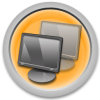Setting up an image archive, sizes, resolution, etc.
Logos Flow products use the principle that it is better to link an image to a database, rather than store it in the actual database. For example, if you place a large high resolution image into a database, the size of the actual database will increase dramatically. Rather, offer a
link to the image, whether it is of a high or low resolution.
The ideal is:
- the ability to link to images when required
- the ability to open the linked image with whatever application is associated with images on your computer
- the ability to view a thumbnail from within the product or database
- the ability to have different views on the image from within the database, i.e. clip, stretch or zoom
To offer the various options required for imaging,
hypertext / hypermedia technology is used. Take a look at
Hyperlink below that describes how this works.
Setting up an archive of digital images: a suggestion
Create a folder on your computer, or network server, where all your images can be stored. You can create further sub-folders if you need to further divide the image files (i.e.
c:\dataflow\images\art). Another benefit: ff you create a sub-folder under the
c:\DataFlow folder called
/Images/ then if you
backup (see below) the
c:\DataFlow then all the data, and related images, are also backed up.
Setting up an archive of digital images on a network: if you are networking your database product and need to setup an image bank, it is advised that you create a shared folder that is accessed by all users on your network. Place images linked to the database within this folder.
If you are using one of the products that
automatically generates
unique numbers for each record then use this number in the image file name (i.e.
120 could be an image file called
120.jpg).
If you are using one of the products that manually generates , then the accession or identity numbers that you give the items can be the image file name (i.e. 2000/1 could be an image file called 2000_1.jpg).
Image size and resolution: as images linked to a database are normally for photo documentation purposes, it is better to have a standard size and resolution. Over the years we have found the following to be ideal:
- Resolution: 72 dpi
- Orientation - landscape images: between 900 and 1000 pixels (px) in width
- Orientation - portrait images: between 600 and 700 pixels (px) in width
- Image quality - 85%
Please note the above sizes are a generalised standard, use your discretion it you have an image of something that is narrow and wide, or narrow and tall.
Tip
If you move, or delete an image file, or files, then the link from your product to the file will be incorrect. You will be notified that the file has moved if you try to activate the file via a
Hyperlinks form. You can then change the link manually, or remove the link if the file was deleted.
If you move an entire collection of image files, then use the
search and replace option to globally change the actual link information.
Zoom
This form lets you use a variety of options to view an image. Note that if you wish to edit the image then click the actual
hyperlink as this will open the image in whatever application on your computer that you use to edit images.
- Zoom view: literally fills the image frame with the image but keeps the correct proportions.
- Clip view: shows the actual size of the image, either the image will be reduced in size in the frame or enlarged, depending on the size of the actual image.
- Stretch view: makes the image fill the frame regardless of it's size and does not keep proportion.
- Tile view on: tiles the image in the frame.
- Tile view off (default): does not tile the image in the frame.
Sample zoomed image

Sample clipped image

Sample stretched image


